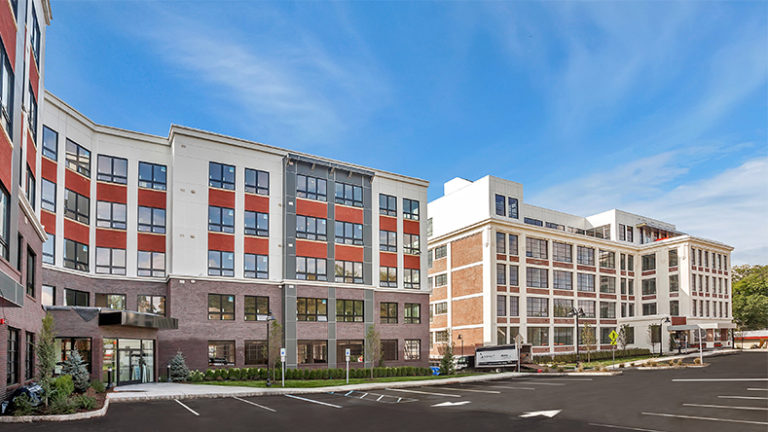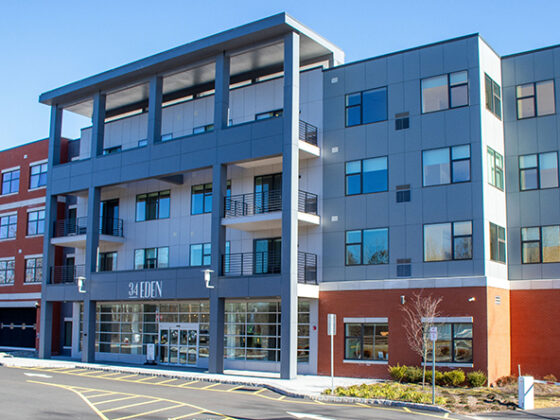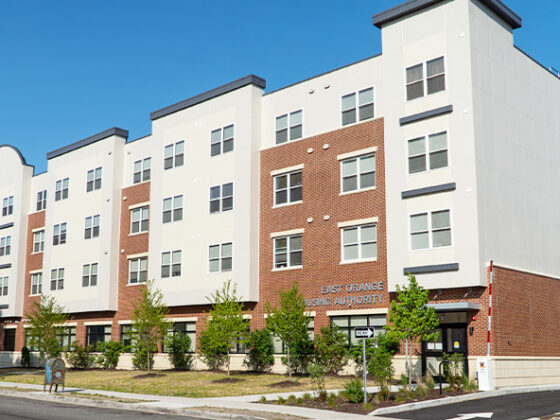by Martin Daks
When folks move into Annin Lofts, a 52-unit edifice at 163 Bloomfield Ave. in Verona, the apartments will have that just-built scent, but the building—an Annin Flag factory for 94 years—is anything but new.
Russo Development and Dinallo Construction Corp. took the nearly century-old structure and updated it for residential use, with move-ins to start this year.
The project is part of a well-established trend: Some 43,000 historic rehabs were completed in the past 40 years, with New Jersey projects representing a $500 million slice of the $90 billion in project outlays, according to a study by Rutgers Edward J. Bloustein School of Planning and Public Policy.
“We were attracted by the potential of the Annin structure,” said Ed Russo, CEO of Russo Development and a member of the joint venture D&R Verona. “When you’re away from the waterfront urban areas, you don’t see many 100-year-old, high-ceiling, concrete buildings. The opportunity of constructing loft-style units in a suburban area made it stand out, and the town was in favor of it.”
When developers rehabilitate an older structure like the former Annin factory, some apply to the National Park Service for an official historic certification and related federal tax credits. Russo and his joint venture partners decided against that.
“We considered that option, but an outside consultant advised against it,” Russo said. “He said it could be done, but it would be more complicated.”
Even without the official designation, the lure of the building was its historic character—and staying true to it meant the project would be challenging in any event
“Even though we gutted the interior, we still had to run electrical lines and mechanical and other distribution systems through concrete floors, which required more than 600 cuts,” Russo said. “It’s not just a matter of cutting through concrete, because preserving the original design meant that in some cases we couldn’t cut through existing floors, and had to reconfigure and coordinate the apartment layouts.”
There were other issues, like remaining true to the window designs. Factories built in the early 1900s tended to have extra-large windows, 20 feet or longer to let in a lot of natural light; they were replaced with energy-efficient ones.
“We had to design the apartment units to work within the confine of the existing windows,” said Kurt Vierheilig, senior project manager, partner and director of design for DMR Architects, which designed the repurposed structure and a new, matching 60-unit building adjacent to it.
“We were able to keep the feel of the older, larger windows,” Vierheilig said. “If this project had been certified as a historical one, we probably would have had to go even further, like matching the thickness of the original [glass partitions].”
Such painstaking planning adds time and costs to the construction process, but it’s all part of building a desirable property, Russo said.
“Of course, it’s got to be in an area that will support the rent, but a historic building is unique and attracts people across demographics,” he said. “Usually the demand for loft-style construction comes from younger people, but here we’re seeing demand from residents who are downsizing but want stay in Verona. There’s not a lot of new product being built here, and Annin Lofts stands out.”
A rich tapestry of history and a high foot traffic were the attractions for Paramount Assets in acquiring Ironbound Plaza in Newark, a triangular-shaped, limestone-clad building at 2 Ferry St.
The property started life around 1905 as a bank and later was converted for medical use. After a redesign, it houses a Blink Fitness—the fitness chain’s first Newark location, opening April 27—and a soon-to-open 7-Eleven convenience store.
“Municipalities like to preserve a city’s character,” said Richard Dunn, senior vice president of Paramount Assets. “Knowing Newark and the history of the Ironbound section was a key to preserving the façade of the structure while returning retail to the area.”
Adjacent to Newark Penn Station, an estimated 30,000 people a day pass by the building.
Paramount Assets wanted to preserve the exterior to maintain the building’s history, “but inside people still want modern facilities,” said Dunn. “The challenge was the greatest on the outside, where any repair and maintenance have to match the era’s look.
“Fortunately, Paramount Assets has done a lot of this kind of adaptive reuse, including Newark properties like Halston Flats at 127 Halsey St., where we engaged in an eco-friendly restoration of a historic industrial building constructed at the turn of the 20th century on the banks of the former Morris Canal. That development now includes 16 luxury apartments and 4,000 square feet of street-level retail.”
Said Blink Vice President of Real Estate Bill Miller: “We recognize that the Ironbound Plaza is a historically significant property. We’re looking forward to preserving the space’s history while also providing a service to the local community.”
Some historic properties are converted from private use to a public one.
Hackensack Performing Arts Center at 102 State St. was part of a strategic plan to revitalize the downtown district into a mixed use, pedestrian-friendly area. The city of Hackensack purchased the 140-year-old old Masonic Temple with the goal of rehabilitating it as cultural and performing arts center.
“The building was constructed as a kind of assembly hall more than century ago, when most of the people would be on the ground floor,” said Francis Reiner, a partner and senior project manager with DMR Architects. “Repurposing the former Masonic building as a theater meant opening up and reinforcing below-ground footings and foundations so they could bear the load of crowds on the second floor.”
The firm’s projects have included the HACPAC and the ongoing rehabilitation of a train station in Bloomfield listed on the National Register of Historic Places.
The HACPAC’s 224-seat theater space has a second-floor stage with access to first-floor dressing rooms through spiral staircases. While maintaining the look and feel of the building, Reiner and his team had to bring it up to modern safety and accessibility standards with new bathrooms, heating and cooling systems, sprinkler systems, ramps, an elevator and other mechanical and other devices.
“It was a challenge,” he said. “But we had the support of the city and the community, and the first performance was on Nov. 11, 2017. Every weekend since then has been booked by community and regional performers and others.”
The Bloomfield train station — at Washington Street and Glenwood Avenue, across the street from a mixed-use development — has its own quirks.
Built in the early 1900s, the property is listed on the National Register of Historic Places. As a result, there are significant restrictions on the restoration, which is still in the planning stage.
“The materials and design for the renovation have to match the original design,” said Reiner. “Fortunately, we found the original architectural drawings, but we had to work with a historic preservation specialist to find matching materials or the best match. For example, the concrete mixture back then used shells, shale, rock and stone.”
But such challenges are worth the effort, he stressed.
“When you’re done, you have an iconic structure,” Reiner said. “They spur activity—new properties have already gone up near the Bloomfield train station—and they enhance an area’s appeal.”
This article originally appeared in NJBiz.





